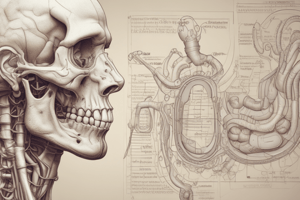Podcast
Questions and Answers
What is the primary function of bile salts in the digestive system?
What is the primary function of bile salts in the digestive system?
What is the main consequence of cholestatic liver disease?
What is the main consequence of cholestatic liver disease?
Which component of bile is responsible for giving feces its brown color?
Which component of bile is responsible for giving feces its brown color?
What is the primary cause of gallstones?
What is the primary cause of gallstones?
Signup and view all the answers
What is the role of the gallbladder in relation to bile?
What is the role of the gallbladder in relation to bile?
Signup and view all the answers
In which part of the small intestine are bile salts primarily reabsorbed?
In which part of the small intestine are bile salts primarily reabsorbed?
Signup and view all the answers
What condition is characterized by chronic inflammation of the liver?
What condition is characterized by chronic inflammation of the liver?
Signup and view all the answers
How does the liver respond to a significant loss of tissue?
How does the liver respond to a significant loss of tissue?
Signup and view all the answers
What is the primary function of the gallbladder?
What is the primary function of the gallbladder?
Signup and view all the answers
Which structure separates the right and left lobes of the liver?
Which structure separates the right and left lobes of the liver?
Signup and view all the answers
What is the function of hepatocytes in the liver?
What is the function of hepatocytes in the liver?
Signup and view all the answers
What type of blood vessels are the liver sinusoids?
What type of blood vessels are the liver sinusoids?
Signup and view all the answers
Which of the following provides the liver with oxygen-rich blood?
Which of the following provides the liver with oxygen-rich blood?
Signup and view all the answers
What role do stellate macrophages play in the liver?
What role do stellate macrophages play in the liver?
Signup and view all the answers
Which of the following components is NOT part of the portal triad in a liver lobule?
Which of the following components is NOT part of the portal triad in a liver lobule?
Signup and view all the answers
How much bile do hepatocytes produce daily?
How much bile do hepatocytes produce daily?
Signup and view all the answers
Flashcards
Liver's digestive function
Liver's digestive function
Produces bile, which emulsifies fats.
Gallbladder's role
Gallbladder's role
Stores bile produced by the liver.
Liver size
Liver size
The largest gland in the body, approximately 3 pounds.
Liver lobes
Liver lobes
Signup and view all the flashcards
Liver's blood supply
Liver's blood supply
Signup and view all the flashcards
Liver lobules
Liver lobules
Signup and view all the flashcards
Portal triad contents
Portal triad contents
Signup and view all the flashcards
Hepatocytes function
Hepatocytes function
Signup and view all the flashcards
Bile salts function
Bile salts function
Signup and view all the flashcards
Enterohepatic circulation
Enterohepatic circulation
Signup and view all the flashcards
Gallbladder function
Gallbladder function
Signup and view all the flashcards
Bile composition
Bile composition
Signup and view all the flashcards
Hepatitis
Hepatitis
Signup and view all the flashcards
Cirrhosis cause
Cirrhosis cause
Signup and view all the flashcards
Gallstones cause
Gallstones cause
Signup and view all the flashcards
Obstructive Jaundice Cause
Obstructive Jaundice Cause
Signup and view all the flashcards
Study Notes
Liver, Gallbladder, and Pancreas
- Liver, gallbladder, and pancreas are accessory organs for the small intestine.
- Liver: Produces bile, a fat emulsifier.
- Gallbladder: Stores bile.
- Pancreas: Provides digestive enzymes and bicarbonate to neutralize stomach acid.
Liver Gross Anatomy
- Largest gland (around 3 lbs).
- Four lobes: right, left, caudate, and quadrate.
- Falciform ligament divides the larger right and smaller left lobes, suspending liver from the diaphragm and abdominal wall.
- Round ligament, a remnant of the umbilical vein, is along the free edge of the falciform ligament.
- Lesser omentum attaches the liver to the stomach.
- Blood enters through the hepatic artery and hepatic portal vein at the porta hepatis.
- Bile ducts include the common hepatic duct, cystic duct, and the bile duct.
Liver Microscopic Anatomy
- Liver lobules: hexagonal functional units composed of hepatocytes (liver cells) filtering and processing nutrient-rich blood.
- Central vein in the longitudinal axis of lobule.
- Portal triad in each corner: hepatic artery branch (oxygen), hepatic portal vein branch (nutrient blood), and bile duct.
- Liver sinusoids: leaky capillaries between hepatocyte plates.
- Blood from hepatic portal vein and hepatic artery proper flows through sinusoids and to central vein.
- Stellate macrophages remove debris and old red blood cells.
- Hepatocytes have increased rough and smooth ER, Golgi apparatus, peroxisomes, and mitochondria.
- Hepatocytes produce approximately 900 ml of bile daily, process blood nutrients (glucose storage as glycogen, plasma protein production), store fat-soluble vitamins, and detoxify (e.g., ammonia to urea).
Bile
-
Yellow-green, alkaline solution containing:
- Bile salts (cholesterol derivatives), for fat emulsification and absorption.
- Bilirubin (pigment from heme), broken down in intestine to stercobilin (brown feces).
- Cholesterol, triglycerides, phospholipids, and electrolytes.
-
Enterohepatic circulation: bile salts reabsorbed in ileum, returned to liver via hepatic portal blood, and recycled (about 95%).
Gallbladder
- Thin-walled muscular sac on liver's ventral surface.
- Stores and concentrates bile by absorbing water and ions.
- Contains folds to expand during filling.
- Muscular contractions release bile via cystic duct into bile duct.
Liver and Gallbladder Imbalances
- Hepatitis: liver inflammation (viral, drug toxicity, obesity).
- Cirrhosis: chronic inflammation (hepatitis, alcohol), progressive scar tissue regeneration faster than hepatocytes.
- Liver transplants are successful but livers are scarce; livers can regenerate to full size in 6–12 months after 80% removal.
- Gallstones: from excess cholesterol or insufficient bile salts.
- Obstructive jaundice: blockage of bile flow, leading to buildup of bile salts/pigments and yellow skin.
- Gallstone treatment: drug therapy, ultrasound vibrations (lithotripsy), laser vaporization, or surgery.
Studying That Suits You
Use AI to generate personalized quizzes and flashcards to suit your learning preferences.
Description
This quiz explores the anatomy and functions of the liver, gallbladder, and pancreas, focusing on their roles in digestion and metabolism. It covers both gross and microscopic structures, highlighting their importance as accessory organs for the small intestine. Test your knowledge on the liver's lobes, blood supply, and bile production.





